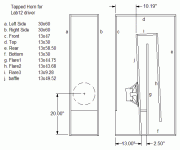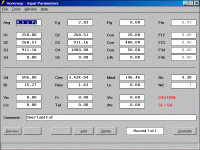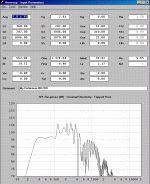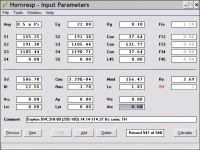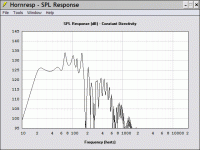gibbed said:MaVo - I planning on building a pair of your 38 Hz Tang Band tapped horns.
Thats not me, its Volvotreter you seek.
cowanaudio said:It makes the horn big. No other reason. When a Tapped Horn becomes very large, it no longer has an advantage over a FLH.
Bigger is still better, in an absolute sense. The smaller one is only better in a relative sense (relative to a similar sized flh). Its cool in a technical way to have a "size efficient" design, which makes alot of sound out of a small enclosure, but making it bigger makes it sound better.
The reason one doesnt see so big ths is simply that they are so big. Virtually no one wants a cubic meter of subwoofer.
BIB rules for sure, but yeah, even I 'draw the line' at ~30 ft^3 (~0.85 m^3) cabs for various reasons.
GM
GM
Chris8sirhC said:I was meaning to say that without eq, there arent any designs that can go from 20 to 80hz. With eq there are plenty, and the lab12 design i will be building is one of them.
OK, that makes more sense 🙂
GM said:
Sorry, no, you'll just have to do a search of 'GM' and isolate the posts on this thread AFAIK. With 547 TH designs currently in Hornresp it's not simple to find them scanning it either.
GM
No worries GM, I'll do some searching and do some comparisons before I post up my design for criticism/suggestions.
Special Ed said:
Has anyone built or run the numbers for the Dayton DVC 12"?
Not till now AFAIK. Using published specs it looks good enough in a ~14 Hz, ~362 L conic TH, though it really wants to be in a larger, longer, lower tuned TH.
Well, I've tried repeatedly to post the Hornresp specs, but I keep getting an upload error message.
GM
Samuel Jayaraj said:Don Snyder, would you have a frequency response graph for this fold? Which Eminence driver is this as per their catalogue?
Thanks,
Bump!!
Thanks again,
With all of the concerns about limited frequency coverage with tapped horns, and some considering using two separately tuned THs to cover the range between sub and low mid-bass, it got me thinking. Why not use two drivers placed in parallel next to one another along the horn? Given the typical folding, the "bottom" (assuming folding as per William Cowan) would have the longest horn length, and thus the lowest tuning. The "top" would have a somewhat decreased path length, and thus a higher tuning. The advantage here is space savings, increased output, and double the power handling (and perhaps better handling around 80-120 Hz). Plus, the two wired in parallel electrically would drop impedance by 1/2, which would achieve greater current draw from the amplifier.
Does anyone know how two speakers operating in a folded/tapped horn would operate? Can Hornresp or Akabak (sp?) model such a dual driver horn? Would this work, or would the two drivers be likely to cancel each other out at certain frequencies?
Does anyone know how two speakers operating in a folded/tapped horn would operate? Can Hornresp or Akabak (sp?) model such a dual driver horn? Would this work, or would the two drivers be likely to cancel each other out at certain frequencies?
With 2 drivers in the same horn folding and at different positions, the "path lengths" are still the same. It's their relationships with 'nodes" are different.
The lowest tunings are probably the same, and with some bigger zig-zag response provided by the 'higher' driver.
The lowest tunings are probably the same, and with some bigger zig-zag response provided by the 'higher' driver.
@Craigwalsh: A few months ago I made a series of AkAbak scripts with a passive radiator in the "Tap" position of a TH. I've made these to try to create a horn system that could be calculated using the assumptions of Leach' Horn model, but regarding to a TH system the problem of finding out the exact parameters for the passive radiator stayed the same.  As far as I know, the only person who can have a paper/model for THs similar to the Leach paper, is Tom Danley and I doubt he will release such a thing.
As far as I know, the only person who can have a paper/model for THs similar to the Leach paper, is Tom Danley and I doubt he will release such a thing.
Anyway, I seem to have lost the series of scripts (I'll look again later), but I sent them to GM as study/discussion material and maybe he still has them somewhere lying around and can post them here.
Removing the PR references and dropping in a second driver to model the response, would be a quick "hack" for what you need.
 As far as I know, the only person who can have a paper/model for THs similar to the Leach paper, is Tom Danley and I doubt he will release such a thing.
As far as I know, the only person who can have a paper/model for THs similar to the Leach paper, is Tom Danley and I doubt he will release such a thing.Anyway, I seem to have lost the series of scripts (I'll look again later), but I sent them to GM as study/discussion material and maybe he still has them somewhere lying around and can post them here.
Removing the PR references and dropping in a second driver to model the response, would be a quick "hack" for what you need.
for a double use i prefer my development:
http://www.diyaudio.com/forums/showthread.php?s=&threadid=97674&perpage=5&highlight=&pagenumber=352
post 1758
and on my HP.
http://www.diyaudio.com/forums/showthread.php?s=&threadid=97674&perpage=5&highlight=&pagenumber=352
post 1758
and on my HP.
craigwalsh said:Does anyone know how two speakers operating in a folded/tapped horn would operate?
My guess:
Since a tapped horn (the enclosure) has a very close relationship with the driver in it, unfitting TS paramters easily lead to a bad response. Under the assumption that the two drivers have different parameters, i would guess, that there will be no possible solution in which the horn produces a usable response with both drivers. If both will work with the horn, it also implies that their TS parameters are quite the same and this case gives no advantage above using two identical drivers.
2nd guess:
Since the drivers will be quite close one could get the idea, that they could work as a single driver with paramters somehow inbetween those of both single drivers. If one could compute the mixed TS parameters, once could design a horn for them, but this would just be like every other single driver horn.
Conclusion:
After all, i think the horn limits the bandwith of the driver, thus using different drivers will still lead to the same bandwidth.
mavo,
only a guess?
did you read about what on my HP?
I did it in real with real measurements.
only a guess?
did you read about what on my HP?
I did it in real with real measurements.
Maybe this was allready covered, but i cant find / remember. The TH-115 spec sheet specifies an SPL peak of 136db at 2000W. When i simulate it in hornresp, i get a displacement limited spl of around 128-130db. Where do the extra 6-8 db come from? Is the excursion graph in Hornresp not exact or does DSL use modded drivers with over 25mm xmax, which would be necessary for a 136db peak, instead of the normal 15TBX100 which has 11mm xmax?
CLS said:With 2 drivers in the same horn folding and at different positions, the "path lengths" are still the same. It's their relationships with 'nodes" are different.
The lowest tunings are probably the same, and with some bigger zig-zag response provided by the 'higher' driver.
Right, assuming we're not talking about an extreme offset, the WLs are so long the TH will 'feel' an acoustically oblong driver down low, so all that's changing is its HF corner, ergo the design should be based on this virtual single driver's acoustic center.
IOW this is going in the wrong direction since you're actually lowering the TH's HF corner rather than raising it.
GM
- Home
- Loudspeakers
- Subwoofers
- Collaborative Tapped horn project
